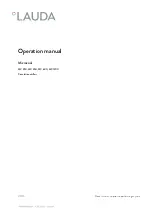
Corporate Office: 724.584.5500
Instant Access 24/7 (Parts and Service): 800.458.1960
Parts and Service
:
814.437.6861
8
Pre-Installation
Receiving Inspection
When the unit arrives, verify it is the correct unit by
comparing the information that appears on the unit
nameplate with that which appears on the order
acknowledgement and shipping papers. Inspect the
equipment condition for any visible damage and
verify all items shown on the bill of lading are
present. If damage is evident, properly document it
on the delivery receipt and clearly mark any item
with damage as “unit damage” and notify the carrier.
In addition, make note of the specific damage and
notify Conair’s Service Department.
Shipping damage is the responsibility of the carrier.
To protect against possible loss due to damage
incurred during shipping and to expedite payment
for damages, it is important to follow proper
procedures and keep records. Photographs of
damaged equipment are excellent documentation
for your records.
Start unpacking the unit, inspect for concealed
damages, and take photos of any damages found.
Once received, equipment owners have the
responsibility to provide reasonable evidence that
the damage did not occur after delivery. Photos of
the equipment damage while the equipment is still
partially packed will help in this regard. Refrigerant
lines can be susceptible to damage in transit. Check
for broken lines, oil leaks, damaged controls, or any
other major component torn loose from its
mounting point.
Record any signs of concealed damage and file a
shipping damage claim immediately with the
shipping company. Most carriers require concealed
damages be reported within 15 days of receipt of
the equipment. In addition to notifying the carrier,
notify Conair’s Service Department.
Water-cooled chillers ship with a full refrigerant
charge while remote condenser chillers ship with a
nitrogen holding charge. Remote air-cooled
condensers ship separately with a 350-psi dry
nitrogen gas charge. Check the remote condenser
for signs of leaks prior to rigging. This will ensure no
coil damage has occurred after the unit left the
factory. The condenser ships with the legs removed.
Mount the legs to the condenser using the provided
nuts, bolts, and washers.
Unit Storage
If the chiller is stored prior to installation, it is
important to protect it from damage. Blow out any
water or fluid from the evaporator and water-cooled
condenser circuits to protect the unit from damage
from freezing. Close any open refrigerant valves.
Cover the equipment to keep dirt and debris from
accumulating on it. Units charged with refrigerant
should not be stored in areas warmer than
145°F (62.8°C).
















































